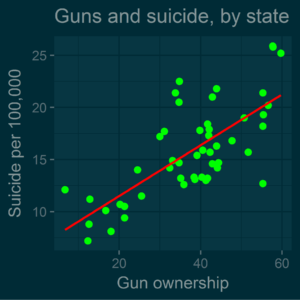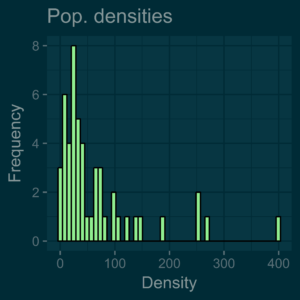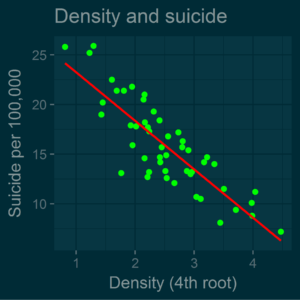Guns, suicide, and population density
 It’s probably not the right time for a Brit to comment on Americans and guns. Over the last few months there has been a wave of knife-murders in London, giving it a higher murder rate than New York. Perhaps if more Londoners had guns, the murder rate would be lower. If I lived alone, I would certainly buy a gun. Not because it would make me safer, but out of curiosity. From a British perspective, having a gun in your own home is so weird, you’ve just got to try it, unless your wife says otherwise. There may also be a societal obligation to own a gun. Burglary rates are lower in the US than in the UK, and one reason may be the deterrence of unregistered gun ownership. If you’re a burglar, you don’t know whether your intended victim is a gun owner. Even a bed-ridden 95-year old woman could have a Gloch under her pillow. This means that those of us who don’t own guns are parasites, relying on gun owners for their passive protection. If people stopped owning guns, burglary rates might start rising. It’s a similar situation with vaccinations. If you don’t vaccinate your kids against measles, you’re relying on other families to vaccinate their children. Why should I risk my children getting a bad reaction to the vaccine? Let other children take the risk, and let my child get the benefit. Yet if vaccination rates fall below a certain threshold, the benefits of public vaccination programs start declining.
It’s probably not the right time for a Brit to comment on Americans and guns. Over the last few months there has been a wave of knife-murders in London, giving it a higher murder rate than New York. Perhaps if more Londoners had guns, the murder rate would be lower. If I lived alone, I would certainly buy a gun. Not because it would make me safer, but out of curiosity. From a British perspective, having a gun in your own home is so weird, you’ve just got to try it, unless your wife says otherwise. There may also be a societal obligation to own a gun. Burglary rates are lower in the US than in the UK, and one reason may be the deterrence of unregistered gun ownership. If you’re a burglar, you don’t know whether your intended victim is a gun owner. Even a bed-ridden 95-year old woman could have a Gloch under her pillow. This means that those of us who don’t own guns are parasites, relying on gun owners for their passive protection. If people stopped owning guns, burglary rates might start rising. It’s a similar situation with vaccinations. If you don’t vaccinate your kids against measles, you’re relying on other families to vaccinate their children. Why should I risk my children getting a bad reaction to the vaccine? Let other children take the risk, and let my child get the benefit. Yet if vaccination rates fall below a certain threshold, the benefits of public vaccination programs start declining.
Guns might protect you against burglary, but what about other things? Suicide for example. The 2016 suicide statistics have been out for some time, and inevitably they are used as a foil against gun ownership. It would seem that states with the highest rates of gun ownership have the highest suicide rates. Of course gun ownership is a difficult thing to work out, as there is no obligation to register your weapons. There are also bad statistics that get passed around the internet. For example, the rate of gun ownership in Hawaii. I have seen reputable sources claim that it is 45.1%, one of the highest in the nation. I have seen other sources reporting 6.7%, which seems more plausible.
Anyway, the standard statistical approach is to create a scatter plot, comparing suicides per 100,000 with gun ownership, by state. You get a graph like this:

The scatter plot clearly shows that as gun ownership increases, so does suicide. The green dot at the bottom is New Jersey, with the lowest suicide rate in the Union, of 7.2 per 100,000. It also has the second lowest gun ownership rate, of 12.3%. At the other end of the spectrum, you can see two green dots on the top right, representing Alaska and Montana. They have suicide rates of respectively 25.8 and 25.9, well over three times that of New Jersey. They also have very high rates of gun ownership, approaching 60%.
However we have to be careful. States with high suicide rates may have particular futures, which attract gun ownership. Such as a low population density. Alaska has a density of 0.43 people per square kilometer, compared with New Jersey, with a density of 400. Here is a histogram of the population densities of the 50 states:

As you can see, it is a rather skewed distribution, so we’ll transform it, using the 4th root:

We can then create a scatter plot comparing suicide with the transformed data:

A beautiful, inverse relationship, with a correlation of -0.85. We also find that gun ownership and the transformed density have a correlation of 0.79. So the higher the population density, the the lower the suicide rate and the lower the rate of gun ownership. We can then do a hierarchical regression, trying to predict the suicide rate per 100,000:

When we try to predict the suicide rate just with the transformed density, we have an R-squared of .72, meaning we can account for 72% of the variance. The addition of gun ownership to the model raises R-squared to .73. It’s a miserably low increase, which is miles away from being statistically significant. This means that on a state level, one should be careful about arguing that there is a relationship between gun ownership and suicide. What matters is population density.
One can speculate about the reasons for this relationship. In a state like Alaska or Wyoming there may not be easy access to mental health facilities. The isolated environment may also be attractive to people who are ruggedly independent, who don’t believe in asking for help until it’s too late. And of course if you live in such states, you’re more likely to have a gun, either for hunting or for personal protection.
For me, the main takeaway is that the beauty of the great American wilderness conceals a dark shadow. It’s OK to live in the Montana outback if you’re happy and well-balanced, but if you have any doubts about your mental health, you should forget your rural dreams and consider moving to a city. Newark, New Jersey, for example.